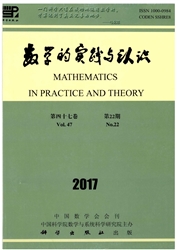
欢迎您!东篱公司
退出

 中文摘要:
中文摘要:
在股价及其走势均不确定的情况下,采用最坏VaR方法,对投资的潜在损失进行最保守的度量,并得到其等价的优化形式为一个二阶锥优化问题.接着考虑相应的投资组合优化问题:如何选择合适的头寸,使得当股票组合的期望收益达到给定水平的情况下,风险最低,即最坏VaR值最小,最后对模型进行实证分析.
 英文摘要:
英文摘要:
In this work, we consider the worst-case Value-at-Risk (VaR) as a risk mea- sure without the information on prices or tendencies of stocks. We obtain a result that its tractable and equivalent representation can be converted to an second-order cone pro- gramming. Then we investigate a corresponding portfolio selection problem, that is, for a given level of expected return, how to allocate the capital so that the the worst-case VaR is minimized. Furthermore, we report some numerical experiments for portfolio optimization.
 同期刊论文项目
同期刊论文项目
 同项目期刊论文
同项目期刊论文
 期刊信息
期刊信息
